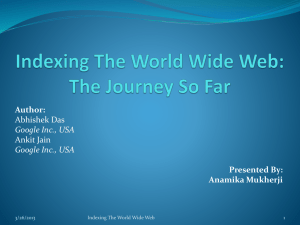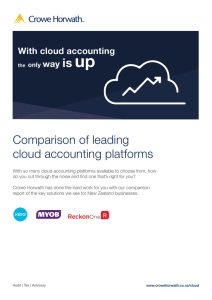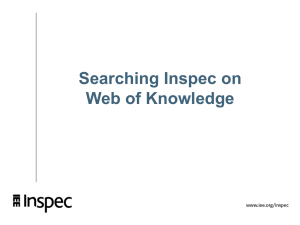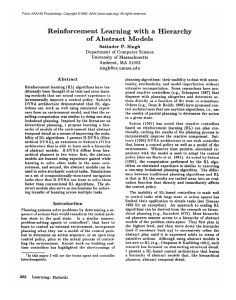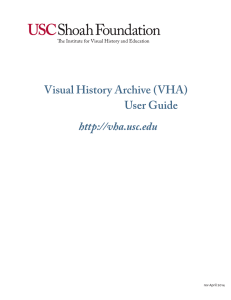5-Constructing strat..
advertisement
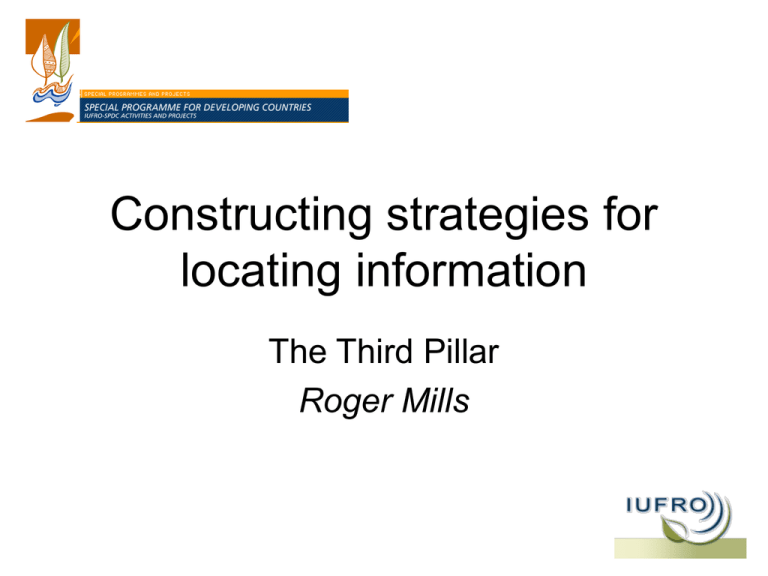
Constructing strategies for locating information The Third Pillar Roger Mills This module • Searching strategies covered in next session • This is about institutional policies • How is information acquired, stored, disseminated • How are different information types integrated 1 STRATEGIES Typically in the old days • Printed, published information would be acquired by the library, by purchase or donation • Library would maintain journal subscriptions • And possibly abstracting/indexing services • Researchers would go to the library • Sometimes information scientists would be employed to review literature and write reports • These reports might be confidential to the individual/group for whom they were prepared, and stored by them • Institution’s intellectual output not stored in library unless published • Large organisations might maintain central registry • Small organisations might depend on efficiency of one secretary – info lost when they move • Correspondence done by typing pool centrally filed When PCs came along • Typing pools disappeared – and so did central filing • Researchers handled own correspondence and own reports, often on own hard disk • Central backups provided but no indexing • Backups not archived – lost when researcher leaves Software • Some provided institution-wide (Windows, Office) • Specialist software provided for or developed by individual researchers, commonly for image manipulation/GIS • Files stay on individual hard disks and can be read by few in institution. Central registry lost. Importance of institutional memory • Now quite widely recognised, but often not much action to preserve it • First essential: institutional audit: who does what, who has what, who knows what • Then (re)define institutional mission: what activities/documentation/knowledge is essential for survival • Then devise strategies to preserve them • Activities: clear management structure, transparent roles, understanding of human resource requirements • Documentation: detailed IT policies [to make it possible], clear responsibilities (documentalist/librarian/information officer/knowledge manager) to make it happen • Knowledge: involves using the information now preserved. Essentially education – knowing what is available in the organisation and how best to exploit it to achieve the aims of the institution • Requires someone in institution to have responsibility for this type of education/induction/training • For which they will need resources: physical, human and financial • Information is not free – even within/about your own organization > must be budgeted for • Failure to resource this area may/will lead to failure to achieve organization's mission 2 MECHANISMS • Centralized or decentralized • IT to serve, not control • Effective communication essential between IT users and IT managers • Rarely achieved, but improving as we talk each other’s language and general IT literacy improves – with ability to distinguish practical from unfeasible, visionary from daft • Financial constraints usually mean adapting systems not ideal for purpose • Beware home-made solutions that only a few understand • Beware complex customization • Simplest and cheapest is often longestlived • If you have a library system (say CDS/ISIS) can you use it for non-library records too? • If you use bibliographic software to record references (say EndNote) can you use it to index and link files across institution? • If you work with other organizations what systems do they use? Using common software can enhance information interoperability and range of people who understand the system • XML as a common file format eases exchange (MS Office will use in place of proprietary formats from next version) • No need to understand how it works to benefit from it • Standard referencing systems for documents/objects simplifies retrieval within and beyond organisation (doi’s) Exercise • How is information managed in your own institution? Sketch out the structure – who is responsible for what, what kind of electronic or manual systems are in use, how are links with other parts of the organization managed? How could things be improved, fom your point of view? What can YOU do about it? 3 Construction and generation of databases • See iMark Management of electronic documents Lesson 5





